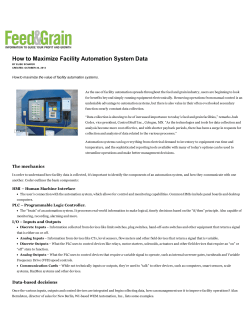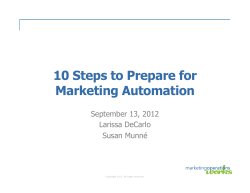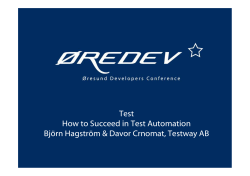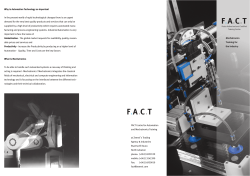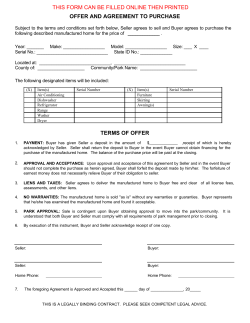
T CMO Guide: How to Evaluate Marketing Technology
This Report Brought to you by: CMO Guide: How to Evaluate Marketing Technology T he change that has occurred with today’s B2B buyer has had a dramatic impact on the role of the CMO. While the traditional state of marketing was a focus on brand, today’s CMOs must focus on creating a perpetual demand generation engine that engages with customers in a one-on-one dialogue. At the same time, Visual CMOs need to create content that engages and delivers high valuetoolkit at every stage of the buying process—while reinforcing their organizations’ brand andicon value. Planet with IBM logo The IBM 8-bar and Smarter Planet icon lock-up identifies While CMOs need to have the right people, process, and strategy accomplish this a conversation as part ofto the Smarter Planet agenda. Use on all communication pieces as the visual link to the customer-driven mandate, they also need to have the right enabling technologies in place in IBM core brand. the correct version for the audience andis application. order to execute. Matching the needs of the business to theUse right technologies no simple (Western, Eastern, vertical, horizontal, black or white). only supplied a artwork. Do not create your own. and task. However, by choosing the right technology, CMOs willUserealize more efficient Do not alter, distort, bleed or crop. effective organization with: Do not lock up with any other typographic or graphic elements such as taglines, messaging or icons. • Increased brand loyalty through high-value customer interactions Do not extract the Smarter Planet icon and use it or locked-up with any other typographic • Higher return on their marketing and sales investments independently or graphic elements. Do not use on the same visual plane as the IBM 8-bar logo. • Tightly aligned marketing and sales teams focused on driving revenue • Improved alignment with the CIO office By Carlos Hidalgo, CEO of ANNUITAS • • • • • • • Please reference the IBM Looks Like and the IBM Smarter Planet guidelines document for additional information regarding this lock-up. Please refer to the Prototypes section in this document to view examples of correct usage of the planet icon with IBM logo. Brought to you in association with C M O G u i d e : H o w t o E v a l u a t e M a r k e t i n g T e ch n o l og y This guide has been developed for CMOs looking to implement technologies that will improve the outcomes driven by marketing. This guide will provide the insights into: • Approaching technology selection by matching organizational needs to the right technologies • Developing the business case for these technology investments • Executing a step-by-step approach to the selection process • Getting started with the necessary elements for success The following questions and answers will help determine organization type and the goals of the business: 1. Is the organization global? Are there multiple geographic regions? If yes, will the technology need to support multiple languages and have 24/7 global support? If the answer is yes to any of these questions, your organization might need a more advanced solution. 2. Do you need to support a complex set of products or multiple business units, including unique demand generation programs to support each business unit or product line? Basic organizations will not have this type of complexity in their offerings. 3. Does your organization intend to own the technology and develop an internal staff or is the plan to outsource? Advanced organizations might use some outside assistance but bring most technology in-house. Some advanced organizations also might use a hybrid approach that mixes in-house and cloud-based technology. 4. Does the organization have complex sales cycle that involves multiple buyers in the decision-making process? Yes for an advanced organization, no for a basic organization. 5. Does the organization have multiple databases and a complex segmentation strategy? Advanced organizations will have more complexity in their data set. 6. Will marketing or IT own the technology? In most advanced organizations, marketing and IT will work in tandem in optimizing the technology. 7. What integrations are necessary or being planned to connect marketing with the rest of the organization? In advanced organizations, the integrations with CRM, business intelligence, web monitoring and social applications will be necessary. 8. How is the marketing organization structured? Does the marketing team sit under one centralized organization or is it distributed across various business units or product lines? 9. What are the revenue goals of the organization? What are the organization’s growth plans? Having a clear picture of the organization and the support marketing will need to provide is the starting point for selecting the right vendor. As you answer these questions, involve multiple teams within your organiza- Organizational Understanding With what seems like an unlimited supply of marketing automation options available, the selection process can seem overwhelming. The first step in this process is getting a clear understanding of your organization and what needs marketing must address, both short-term and long-term. Many marketing organizations jump into technology with no true understanding of what they need to support. In addition, many enterprise organizations are still feeling the weight of out-dated legacy systems and a fractured technology solution approach. These are just some of the reasons that, according to a recent SiriusDecisions study, “75% of marketing automation owners stated they are not getting the full value from their marketing automation investment.”1 Determining your organization type (basic versus advanced) and your needs (simple versus complex) will serve as a guide through the selection process. 2 C M O G u i d e : H o w t o E v a l u a t e M a r k e t i n g T e ch n o l og y tion—sales, finance, IT, various lines of business, operations, etc.—as each will have a unique view and varying needs. Selecting the Right Vendor People Skills Before embarking on the selection process for the right marketing technologies, CMOs should ensure they have the following in place or at the very least being developed: • A clear and well-articulated strategy and vision for the demand generation process needed for marketing • What integration points the marketing technology will have with the organization’s IT stack—business analytics, data warehouse, service management, etc. • A roadmap for implementation including achievement of quick wins while keeping a long-term vision • Development of specific use cases to showcase how technology will better enable buyer engagement Having the people with the right skill sets cannot be overlooked when it comes to having the right technology. This means more than having people trained on how to use the technology. It means ensuring that the right marketing skills and knowledge are present. According to various industry resources, most marketers are ill-equipped to handle today’s modern marketing environment: • 85 percent of marketers describe themselves as “selftaught”2 • 77 percent of marketers rate themselves as either “somewhat or not at all effective” in their roles3 • Less than 50 percent of marketers receive any kind of formal training4 The purpose of technology is to enable marketers to do their jobs most effectively. Implementing technology without the right skill sets will only further expose the lack In addition to the basic questions to be asked of a vendor (ease of usability, reference request, pricing, uptime, support, training, etc.), you’ll need to understand vendors’ processes for: 1. Design and Campaign Management a. Campaign Visualization b. Ability to support multi-stage and channel programs c. Ability to support channels beyond email–direct mail, telemarketing, social media, etc. d. Support of multivariate testing e. Data segmentation and append capabilities 2. Email Marketing a. Does the supplier provide a dedicated IP or shared IP? b. Does the supplier have the ability to develop mobile enabled email? c. What controls does the supplier have for Canned Spam Compliance both within and outside the U.S.? d. What is the sender score? e. Is the email engine native to the vendor or delivered via partnership? 3. Multi-Region Support a. What languages are supported? b. Support of double-byte characters? 4. Landing Pages and Forms a. Can the system support dynamic content? b. Ease of use to create forms and pages? WYSIWIG editor or HTML? Continued on page 4 3 C M O G u i d e : H o w t o E v a l u a t e M a r k e t i n g T e ch n o l og y of expertise. Organizations need to develop or acquire the right skills to achieve optimal marketing performance, including: • Demand Generation & Content Marketing: Developing buyer-centric demand generation campaigns that are fueled by timely and relevant content is a must. This approach requires a demand generation strategist that can effectively develop the buyer personas, define the buyer journey, and map the right content to address the buyer’s needs. In order to support these areas, you’ll need technology that enables engaging with customers as individuals, can provide deep analytics and enable a cross-channel marketing strategy. • Business Process Expertise: Multiple studies have shown that up to 80 percent of all marketing-generated leads do not receive the proper follow-up. The reason for the failure in follow-up is the lack of a defined process between marketing and sales. A lead-management process expert who can develop and implement the necessary process framework is key to marketing becoming a revenue driver. • Analytics: Marketing is about measurement. Marketers must be equipped to measure and analyze the overall performance and revenue impact of their campaigns. This goes beyond impressions, clicks, and open rates. It includes conversion metrics along the funnel, contribution to pipeline, contribution to revenue, and basic ROI measurement. • Technologists: While this function often lies within a marketing operations group, this role is more than someone trained on the general use of the technology. This function requires the combined ability to think strategically and optimize the technology to meet the demands of the business. Ideal candidates for this role have an IT background or IT process mindset, understand technology and integration mapping, and can serve as a liaison to the organization’s IT department. In an effort to bring these functional roles and skills to the organization, many larger companies are developing Centralized Demand Centers. The Demand Center provides organizations a centralized resource that delivers best-practice guidance, technology optimization, and campaign analysis. By centralizing your technology and SELECTING THE RIGHT VENDOR Continued from page 3 c. Does the vendor support A/B testing for landing pages? 5. Technology Integrations a. CRM i. What CRM integrations are out-of-the box versus custom build? ii. Does the integration support automated data mapping to the CRM solution? iii. Can the system be set to not override data during the synch? iv. Can the system support automatic lead re-routing and assignments? b. What other technologies—web analytics, BI, data management, etc.—can be integrated? c. Can you set a priority order for data imports if multiple systems are integrated? 6. Reporting and Analytics a. What reports are standard versus custom? b. Does the solution support metric dashboards? c. What formats are supported for exporting? d. Does the system support pipeline contribution and revenue metrics and reporting? 7. Data Management a. What support does the system supply for opt-in/optout preferences? b. Does the system automatically de-dupe contact records and lead forms? c. Does the system have the ability to support real-time data append and hygiene? During the selection process, the IT team can serve as an invaluable resource because the expertise of buying technology and reviewing vendors is invaluable. In addition, be sure to include representation from other key departments such as sales, channel, and operations. The answers to these questions will help in developing the short list of vendors. Once that list is established, you can arrange customized demos and move into a pilot stage. Ideally, you’ll have two vendors in the pilot stage for a sideby-side comparison. After the pilot is completed, choose the vendor, move to the negotiation stages, and have the vendor detail a project plan for implementation that includes SLAs. 4 C M O G u i d e : H o w t o E v a l u a t e M a r k e t i n g T e ch n o l og y demand generation strategy in one organization and developing the proper skills within the demand center, organizations can see a transformation of their business and their overall return on marketing and sales investments. Here’s one example of the benefits of a centralized Demand Center: This maker of financial software centralized their demand center, including technology, demand creation, content marketing, and analytics. This model yielded an increase of $17M year-over-year from their campaigns, and this increase was attributed to a centralized center of expertise that enabled sales and maximized the value of their marketing spending. learned, and the next planned steps for automation. As a result, several other business units are requesting assistance from the demand center and want to use automation to better drive their revenue goals. 3. Continually Set Expectations: The purchase of marketing automation is much more than just the technology. It’s about fundamentally transforming the way marketing works, and that change takes time. As quick wins are communicated, be sure to address the lessons learned, the changes that are yet to come, and the time it will take to reach a best-inclass status for your organization. Getting Started with Marketing Automation Getting started with marketing automation is crucial. Many organizations lose momentum with technology because of missed expectations. Remember that the technology transformation will not occur overnight, but marketers can achieve some quick wins and should evangelize those internally. Examples of those achievements could be developing a targeted campaign with a simple drip nurturing program or establishing an initial lead-scoring model with sales to prioritize leads. Following this outline will give organizations a game plan on how to implement marketing automation and gain support from the rest of the organization: 1. Educate: As the marketing automation space continues to grow in popularity, everyone in the organization might have ideas about what this technology can do. Take the time to educate the organization on what automation really is, the goals and objectives, the timelines by which goals will be achieved, and what assistance will be needed during this process. 2. Start Small: Marketers are often tempted to immediately begin using automation to support the campaigns. As a starting point, select one business unit or one campaign to support. Take the time to develop the strategy, define the goals, and measure the outcomes. An example: One large enterprise organization took this approach with marketing automation. The marketing team educated the company on automation and worked with one business unit to automate a webinar series. Along with the automation, the organization developed the proper process to ensure optimal return. At the conclusion of the campaign, the marketing owners evangelized the results, the lessons As the change process continues in the organization, you’ll encounter moments of internal resistance. Change of business process is not easy and will take time, but the payoff in terms of improved buyer engagement and increased revenue is worth the hard work. Impacting the Buyer Through Better Buyer Engagement The shift in buyer behavior has forced a change to the CMO’s role and provides an opportunity to increase revenue through better buyer engagement. Technology is now at the forefront of the marketing role, and pairing the right technology with a defined process and strategy will transform the marketing organization. Marketers need to understand the importance of this transformation to help their organizations’ success. Notes & Sources 1 Dawn of the Demand Center – SiriusDecisions, May, 2010 2 iBid 3 Marketing Skills Gap Study, Marketing Automation Institute, April, 2012 4 iBid 5
© Copyright 2025
